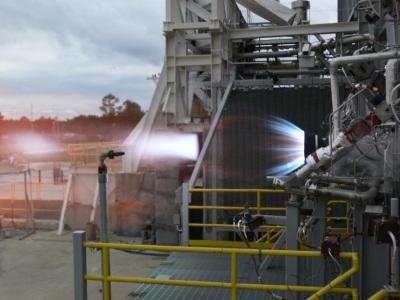Wed, Oct 17, 2012
Will Power Reusable Booster System To Lift Company's Biconic Space Vehicle
NASA's Commercial Crew Program (CCP) partner Blue Origin has successfully fired the thrust chamber assembly for its new 100,000 pound thrust BE-3 liquid oxygen, liquid hydrogen rocket engine. As part of Blue's Reusable Booster System (RBS), the engines are designed eventually to launch the biconic-shaped Space Vehicle the company is developing.

The test was part of Blue Origin's work supporting its funded Space Act Agreement with NASA during Commercial Crew Development Round 2 (CCDev2). CCDev2 continues to bring spacecraft and launch vehicle designs forward to develop a U.S. commercial crew space transportation capability that ultimately could become available for the government and other customers. "Blue Origin continues to be extremely innovative as it develops a crew-capable vehicle for suborbital and orbital flights," said Ed Mango, CCP manager. "We're thrilled the company's engine test fire was met with success."
The test took place early this month on the E-1 test stand at NASA's Stennis Space Center near Bay St. Louis, Miss. Blue Origin engineers successfully completed the test by powering the thrust chamber to its full power level. "We are very excited to have demonstrated a new class of high-performance hydrogen engines," said Rob Meyerson, president and program manager of Blue Origin. "Access to the Stennis test facility and its talented operations team was instrumental in conducting full-power testing of this new thrust chamber."
As part of CCDev2, Blue Origin also completed a system requirements review of its spacecraft. During the review, engineers and technical experts representing NASA, the Federal Aviation Administration and the company assessed the spacecraft's ability to meet safety and mission requirements to low-Earth orbit. That review also included results from more than 100 wind tunnel tests of the vehicle's aerodynamic design, stability during flight and cross-range maneuverability.
(NASA image of Blue Origin rocket motor test)
More News
From 2023 (YouTube Version): Legacy of a Titan Robert (Bob) Anderson Hoover was a fighter pilot, test pilot, flight instructor, and air show superstar. More so, Bob Hoover was an i>[...]
Get The Latest in Aviation News NOW on Instagram Are you on Instagram yet? It's been around for a few years, quietly picking up traction mostly thanks to everybody's new obsession >[...]
Aero Linx: B-52H Stratofortress The B-52H Stratofortress is a long-range, heavy bomber that can perform a variety of missions. The bomber is capable of flying at high subsonic spee>[...]
Altimeter Setting The barometric pressure reading used to adjust a pressure altimeter for variations in existing atmospheric pressure or to the standard altimeter setting (29.92).>[...]
"Knowing that we play an active part in bettering people's lives is extremely rewarding. My team and I are very thankful for the opportunity to be here and to help in any way we ca>[...]
 Classic Aero-TV: Remembering Bob Hoover
Classic Aero-TV: Remembering Bob Hoover ANN FAQ: Follow Us On Instagram!
ANN FAQ: Follow Us On Instagram! ANN's Daily Aero-Linx (05.15.24)
ANN's Daily Aero-Linx (05.15.24) ANN's Daily Aero-Term (05.15.24):Altimeter Setting
ANN's Daily Aero-Term (05.15.24):Altimeter Setting Aero-News: Quote of the Day (05.16.24)
Aero-News: Quote of the Day (05.16.24)



